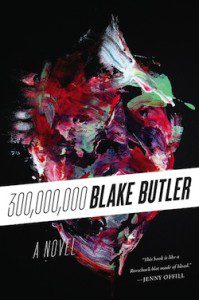
Around the time I finished Blake Butler’s 300,000,000, the New York Times Magazine published “The Death of Adulthood in American Culture” by A.O. Scott. The essay added, in part, to the debate about whether grown men and women should read young adult literature, but it also displayed another cultural preoccupation, one that Butler confronts in his bold and audacious new novel: In the United States, we are surrounded with constant references to death. The death of the publishing industry. The death of print. The death of the CD, of cable, of broadcast news.
It’s at the level of language and images that Butler addresses this morbid, American obsession in 300,000,000. “A forty-five-year-old Caucasian male,” Gretch Gravey, enlists boys to help him dispose of young women and store their bodies in the cellar below his suburban home, which transforms into a skin-laced piece of abstract art. Gravey’s alter-ego—the God-like entity that apparently controls him and the worshipping boys —is called Darrel, and it’s through these killings that Gravey thinks he will create, in his basement, the city of Sod, his version of the world-to-come. The man tasked with investigating the murders, E.N. Flood, reads and annotates Gravey’s notebook, providing his own observations as well as testimonies from the man’s followers. As the detective explores Gravey’s homemade catacombs, detailing everything in a journal, he falls into madness, his thoughts becoming eerily similar to those of the psychopathic criminal.
300,000,000 began as a response to Roberto Bolaño’s 2666, though Butler’s original plan, he admits in a Vice article, wasn’t to compose a complimentary novel but to rail against the Chilean, to respond “to every single sentence, explaining why [he] found it dull and uninspired.” Of course, he didn’t do that, and what we have, instead of a screed demeaning Bolaño, is a piece of fiction that’s very much in conversation with another.
On a note to 2666’s first edition, the literary critic Ignacio Echevarría Pérez reveals that Bolaño believed his novel’s “‘hidden center,’” the “enigmatic” date 2666, is “concealed beneath what might be considered [its] ‘physical center,’” Santa Teresa, the fictionalized version of Ciudad Juárez, where, since the 1990s, hundreds of women have been killed. In that same manner, 300,000,000 (roughly the population in the United States) serves as Butler’s “‘hidden center,’” though it’s shrouded, not in a definitive place, but rather in “any house in America.”
The American home has always been a point of fascination for Butler. There Is No Year chronicles a family driven insane by its home; and Nothing, a non-fiction account of insomnia, is filled with moments when Butler’s childhood house shifts shapes, when he tries to find rooms that don’t exist, when he insists that “all houses could be the same house.” But in 300,000,000, when Gravey has “240+ light fixtures on his property,” or when Flood claims to find “exposed passage[s]” connecting “all the homes” in America, Butler achieves his most candid critique yet: It’s our fault.
We let the killers into our homes, and this implication is in step with Butler’s past fiction. His characters constantly inflict damage on themselves. In Scorch Atlas’s “The Disappeared,” as the country suffers from a widespread plague, the narrator witnesses fellow students commit acts of self-violence: “I watched a girl bang her face in on a blackboard. I watched a boy stick out his eyes.” But here, it’s in a much more subtle and conceptual sense. While the terrifying action in 2666 is the inaction of those in Santa Teresa, the disturbing subtext in 300,000,000 is that the American mind, our almost sexual craving for watching bloodshed, is what’s to blame for Gravey’s actions. For Butler, the incident in 2666 when the literary critics, Pelletier and Espinoza, beat up a Pakistani cab driver in London and feel as if “they’d finally had the ménage à trois they’d so often dreamed of” with another scholar, isn’t something rare, or even contained: It’s something Americans see, and desire—on television, on the Internet, in movies—everyday.

Put another way, we have no filter. At a restaurant near the Mexican border, 2666’s Oscar Fate, a journalist, overhears a conversation between a “white-haired man” and his younger friend. The “white-haired man” explains that, in the nineteenth century, “society tended to filter death through the fabric of words,” not wanting “death in the home, or in our dreams and fantasies.” Despite the fact that “the archetypes of crime” never change, our perception does, and if the 1800s leaned toward concealment, then the American present day, in Butler’s view, is the opposite, flooded with noise and pictures and depictions of extreme violence. So much so that the division between the real and the imagined becomes difficult to discern. As Flood appears to become crazed, the book’s consciousness and shifting perspectives are indistinguishable. When the sensory overload peaks, the senses themselves become contradictions: “There is a nameless music pouring from the eyelets of the darkness beyond the window, larger than silence.” And what remains harrowing, throughout the pages, is the novel’s universality: not that this can happen, but that it does. Just as Bolaño structures 2666 into five distinct, albeit overlapping parts, Butler does the same with 300,000,000. While the opening two, “The Part About Gravey” and “The Part About the Killing,” are somewhat “plot-driven” (Gravey commits crimes and is arrested), the final three abandon this “narrative” structure: “The Part About Flood (In the City of Sod),” the book’s third, contains one-hundred pages worth of repetitions, Flood waking in “smoke,” observing bodies, as if he is trapped inside a looping tape; and “The Part About America,” the penultimate section before “The Part About Darrel,” accounts for the deaths of all the nation’s citizens, including a listed history of the United States summarized through inventions and mass murders:
…we invent the thumbtack key punch assembly line Jane Toppan kills at least thirty-one safety razor radio direction finder hearing aid postage meter teddy bear periscope air conditioning…
This isn’t anything new for Butler. He often resorts to illogical lists, asserting something is true, only to show its immediate impossibility, challenging the power and meaning of language (“Their genitals pushed so far out through their pants the dickheads had fists that punched holes in the house”). What makes 300,000,000 a step forward, however, is that when a “thumbtack” is equated to “thirty-one” murders, it’s in the established context that the difference between burying bodies in crawl spaces, and watching such an event on TV, isn’t much of a difference.
In his Vice post on Bolaño, Butler considers that American “literature supports…more who the writer is and what they’ve done.” It can be easy to do the same, and overlook “the body of one’s creation,” with Butler: He is an admirable writer, for me, because he doesn’t seem to give a shit. Controversially, he has been an advocate for transparency on his blog, HTMLGIANT (which is now shut down). For as strange and disturbing as they are, his tweets are bold critiques (“You could replace the vocals in ac/dc songs w/ burning children screaming & i wouldn’t notice the difference”). He is a grounded literary provocateur. He celebrated Scorch Atlas’s publication by destroying a copy. Not long after the essay collection MFA vs. NYC was released Butler tweeted a photograph of himself flipping-off the book. But we should, I think, judge him only on his work. If we do, 300,000,000 is Butler’s best middle finger to date.




